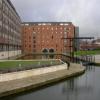
Merchant's Wharf

| Piccadilly Bridge, Manchester | 1½ furlongs | |
| Dale Street Bridge | 1 furlong | |
| Dale Street Lock No 84 | 1 furlong | |
| Ducie Street Junction | ½ furlongs | |
| Vantage Quay Bridge | ¼ furlongs | |
| Merchant's Wharf | ||
| Tariff Street Bridge No 91 | ¼ furlongs | |
| Ancoats Lower Lock No 83 | ½ furlongs | |
| Leech Street Footbridge | ½ furlongs | |
| Great Ancoats Street Bridge No 89 | 1 furlong | |
| Ancoats Upper Lock No 82 | 1 furlong | |
Why not log in and add some (select "External websites" from the menu (sometimes this is under "Edit"))?
Mouseover for more information or show routes to facility
Nearest water point
In the direction of Castlefield Junction
In the direction of Sowerby Bridge Junction
Nearest rubbish disposal
In the direction of Castlefield Junction
In the direction of Sowerby Bridge Junction
Nearest chemical toilet disposal
In the direction of Castlefield Junction
In the direction of Sowerby Bridge Junction
Nearest place to turn
In the direction of Castlefield Junction
In the direction of Sowerby Bridge Junction
Nearest self-operated pump-out
In the direction of Castlefield Junction
In the direction of Sowerby Bridge Junction
Nearest boatyard pump-out
In the direction of Castlefield Junction
Wikipedia has a page about Merchant's Wharf
A merchant is a person who trades in commodities produced by other people, especially one who trades with foreign countries. Historically, a merchant is anyone who is involved in business or trade. Merchants have operated for as long as industry, commerce, and trade have existed. In 16th-century Europe, two different terms for merchants emerged: meerseniers referred to local traders (such as bakers and grocers) and koopman (Dutch: koopman) referred to merchants who operated on a global stage, importing and exporting goods over vast distances and offering added-value services such as credit and finance.
The status of the merchant has varied during different periods of history and among different societies. In modern times, the term merchant has occasionally been used to refer to a businessperson or someone undertaking activities (commercial or industrial) for the purpose of generating profit, cash flow, sales, and revenue utilizing a combination of human, financial, intellectual and physical capital with a view to fueling economic development and growth.
Merchants have been known for as long as humans have engaged in trade and commerce. Merchants and merchant networks operated in ancient Babylonia and Assyria, China, Egypt, Greece, India, Persia, Phoenicia, and Rome. During the European medieval period, a rapid expansion in trade and commerce led to the rise of a wealthy and powerful merchant class. The European age of discovery opened up new trading routes and gave European consumers access to a much broader range of goods. From the 1600s, goods began to travel much further distances as they found their way into geographically dispersed market-places. Following the opening of Asia to European trade and the discovery of the New World, merchants imported goods over very long distances: calico cloth from India, porcelain, silk and tea from China, spices from India and South-East Asia and tobacco, sugar, rum and coffee from the New World. By the eighteenth century, a new type of manufacturer-merchant had started to emerge and modern business practices were becoming evident.





















![The Rochdale Canal. The barge (numbered NH/027/06) moored near Vantage Quay, is full of rubbish. Note the gabions (rocks in wire cages) to screen the concrete wall behind (see also [[3316784]]). by Thomas Nugent – 28 January 2013](https://s2.geograph.org.uk/geophotos/03/31/67/3316790_a97e7d78_120x120.jpg)



![Parsons Passage. A narrowboat seen on the Rochdale Canal [[4116528]]. It seems to be from Sherborne, Dorset as it carries an advert for Ginger & Pickles a children's clothes shop that is next to Parsons butchers in the town. by Gerald England – 08 August 2014](https://s3.geograph.org.uk/geophotos/04/11/65/4116559_34dcc033_120x120.jpg)




